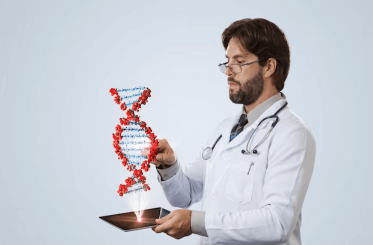Question
a.
Catalytic efficiency
b.
Miachelis Menten constant
c.
Turn over number
d.
Vₘₐₓ
Posted under Enzyme Technology
Interact with the Community - Share Your Thoughts
Uncertain About the Answer? Seek Clarification Here.
Understand the Explanation? Include it Here.
Q. ______________ is defined as an enzyme molecule’s efficiency to convert maximum substrate molecules into product per unit time.
Similar Questions
Explore Relevant Multiple Choice Questions (MCQs)
Q. The equation which is based on reciprocal form of Miachelis Menten equation at constant [Et] level is referred to as ______________
View solution
Q. Which of the following equation is Eadie-Hofstee plot equation?
View solution
Q. Which of the following is termed as catalytic efficiency?
View solution
Q. What does the equation \(V_0=\frac{V_{max} [S]}{K_m+[S]}\) represent?
View solution
Q. What is the ratio of V₀/Vₘₐₓ when [S] = 10Kₘ?
View solution
Q. 4*10⁷: Catalase :: 25: ___________
View solution
Q. ___________ is defined as the enzyme’s binding efficiency with its appropriate substrate through optimized multiple non-covalent interactions.
View solution
Q. Miachelis Menten model is also referred to as “rapid equilibrium model”.
View solution
Q. Which of the following is based on rearrangement of Lineweaver Burk plot equation by multiplication of [S₀] factor?
View solution
Q. What does the following equation represent?
\(\frac{1}{V_0} = \frac{K_m}{V_{max}} \frac{1}{[S]}+\frac{1}{V_{max}}\)
View solution
Q. Which of these is referred to as Kcat?
View solution
Q. Which of the following assumption was not made in rapid equilibrium model?
View solution
Q. Which of these is not required for electrophilic catalysis?
View solution
Q. _____________ involves donation of electrons from nucleophilic active site residues to a substrate forming a covalent adduct transition state intermediate.
View solution
Q. A type of catalysis which involves covalent intermediate transition state formation between the cationic electrophilic group in the enzyme and the electron rich portion of the substrate is referred to as ____________
View solution
Q. Chymotrypsin: Nucleophilic catalysis:: Carboxypeptidase A: __________
View solution
Q. The phenomenon which involves formation of an additional covalent intermediate in a reaction that helps to reduce the energy of later transition states is referred to as ___________
View solution
Q. In the catalysis of RNA by Bovine pancreatic RNase A, His 12 acts as proton donor.
View solution
Q. The type of catalysis wherein the proton donation or acceptance is done by water molecule is referred to as _____________
View solution
Q. Which of the following factor has a negative impact on substrate collision theory?
View solution
Recommended Subjects
Are you eager to expand your knowledge beyond Enzyme Technology? We've handpicked a range of related categories that you might find intriguing.
Click on the categories below to discover a wealth of MCQs and enrich your understanding of various subjects. Happy exploring!








